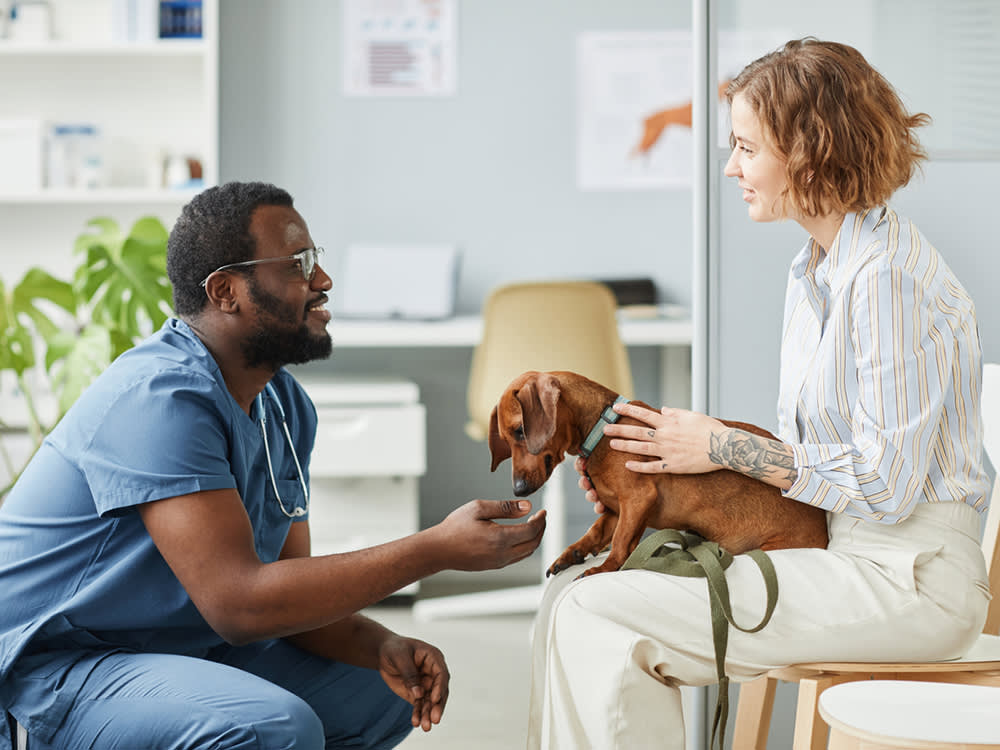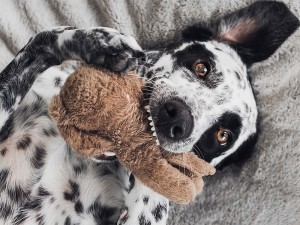Pet Check-Up: 10 Tips for a Better Vet Visit
Become an advocate for your pet during their vet check-ups.
How much easier it would be if vets had Dr. Dolittle’s ability to talk to animals — if your pet could speak for themselves when you take them in for a check-up, things would go a little smoother. Until humans learn to decipher animal thoughts, your pet will rely on you to act as their advocate in the exam room. Here are ten tried-and-true secrets to making every pet check-up exceptional for you and your pet.
1. Find Your Voice
I shun the typical white lab coat because I believe it hinders relaxed, open conversation with pet parents. (I don’t think dogs and cats are crazy about white coats, either.) I’m referring to what is known as the “white coat intimidation factor,” a phenomenon that gives the doctor an air of authority and superiority. When vets are on a “pedestal,” two-way communication flounders. Medical advocacy requires active pet parent participation, and a pet parent who is intimidated does not feel comfortable voicing an opinion. So, before you arrive at the veterinary clinic for your pet’s check-up, find your voice. Remember, this is a simple mind-over-matter endeavor. And if your vet clings fast to their pedestal, consider choosing a different teammate.
2. Be Present
A face-to-face conversation with your vet is invariably more valuable than connecting later via phone or email. Actually being there allows you to view X-rays and see how to administer medication. And don’t forget, given a choice, your pet would absolutely, positively want you to be by their side during a vet check-up. So, do not ask your mother, brother, housekeeper, kid next door, or anyone else to pinch-hit for you. Unless you’ve had recent discussions with your veterinarian to arrange a procedure if at all possible, avoid simply dropping your pet off at the veterinary hospital in the morning before you go to work or school. Lastly, turn your phone off before entering the exam room.
3. Be Honest (About Your Pet’s Behavior)
All pets are capable of unpredictable behavior. A savvy veterinary staff can usually peg an aggressive pet within seconds of meeting them for their check-up. Occasionally, one surprises us and bites — either a staff member or the pet parent. Everyone feels terrible, but it’s made far worse when we learn that the pet parent knew it could happen, but failed to warn us. If your pup has previously growled or attempted to bite or your cat has gone haywire during a vet check-up, you must divulge this information. Trust me, withholding such important information is the quickest, most effective way to alienate yourself from an entire staff, and you will not be welcomed back. The flip side of this coin is that veterinarians have nothing but respect for the client who brings along a muzzle that’s just the right fit.
Pets act out of character in a hospital setting for a number of reasons. Pain, fear, a bad experience, or the need to protect their human can all provoke aggression. Fortunately, there are many humane ways to work effectively with an aggressive pet: chemical sedation or muzzling is a reasonable option. Sometimes, simply separating a pet from their human subdues this aggressive tendency. Brute force is never warranted.
4. Provide Information
The “history” of your pet’s health, past and present, is exceedingly important, more so than many people realize. This often provides more clues for a correct diagnosis than the actual physical examination. Your vet will want to know if you’ve seen any changes in behavior, appetite, thirst, or energy. Report any vomiting, diarrhea, coughing, sneezing, decrease in stamina, or change in bladder or bowel habits. Do some sleuthing on the home front.
Medication And Diet
Bring your pet’s current medication to every vet check-up, so drugs and dosages can be confirmed. Your veterinarian will want the name and strength of the drug, not just a description of the tablet. All too frequently, we come across a prescription that has been dispensed or is being administered, incorrectly. And know the brand name of the food your pet eats. The color of the bag and name of the store where it was purchased simply won’t give your veterinarian adequate information.
Prior Medical Conditions
First-time visitors to a vet clinic should have their pet’s vaccination history and any medical records, laboratory test results, and X-rays that pertain to prior problems. If your pet’s recent symptoms or medical history are somewhat complex, it helps to see a concise written summary of events. By the same token, it is possible to provide too much information. I once received an inch-thick log of many months’ worth of a patient’s bowel movements — including weights and lengths (I couldn’t possibly make this stuff up).
5. Confess Everything
If your pet has trained you to feed them nothing but table food; if you have been sharing your own prescription medication with your pet; if they fell out of the back of a pickup truck because they were not properly tethered; even if your pet has just eaten a plate of marijuana-laden brownies — you must force yourself to rise above any embarrassment or awkwardness and be truthful with your veterinarian.
6: Take a Moment
It is just about impossible to do a reasonable advocacy job if you don’t understand what your vet says. As the saying goes, “What we don’t understand, we can make mean anything.” Most veterinarians, myself included, lapse into “medical speak” because we are so used to these terms running around in our heads. We might say to a pet parent, “Fluffy is in renal failure and needs aggressive diuresis,” instead of, “Fluffy’s kidneys aren’t functioning properly, and we can help him by giving him intravenous fluids.” We need you to stop us in our tracks when we confuse you. If you are a “visual learner,” ask your vet to draw a picture or show you what they are talking about on your dog’s X-rays, lab reports, or ultrasound images. Remember, always “pause for confusion” — when you don’t understand, stop and get clarification.
7. Share Your Concerns
Most veterinarians do what they do because they appreciate how much pets mean to their humans. Who better, then, to empathize with you? To help you, your vet needs you to tell them your particular worries and concerns.
Are you feeling scared or angry? (Anger is a normal stage of the grief process — many people experience it in response to a pet’s illness.) Or are you convinced your pet has a terminal disease that your vet hasn’t checked on? Your vet will be better able to understand your reasoning if they know how you are feeling, and you will receive a much-needed dose of empathy.
It’s never easy discussing financial worries — candor suffers because the subject is often awkward and much too personal. Pet parents feel guilty and worry about being judged when cost needs to be a factor in medical decisions. Be aware, though, you should discuss this matter upfront. Be sure to get an estimate before services are provided so as to avoid any unpleasant surprises. Ask about payment plans or prioritization of services. Most veterinarians are willing and able to provide reasonable financial options.
8. Ask Questions
Asking questions is the most resourceful way to be your pet’s medical advocate. In the heat of the moment, when you have received some disconcerting news, it is easy to forget the important questions you were meaning to ask. It pays to write them down beforehand. No doubt you will do some homework and research when you get home, and you will invariably think of more questions you should have asked. No problem. Veterinarians expect clients to call with questions after they’ve had some time to process and ponder the information they’ve received.
9. Be Respectful
I get really peeved when I learn that a pet parent, who has been sweet as can be with me, has been abrupt, condescending, or rude to one of my staff after a check up. Everyone deserves to be treated with equal respect, and, without a doubt, the entire staff will know if this has not been the case. Likewise, a pet parent who has been respectful and gracious will have the “red carpet” rolled out the next time they visit.
10. Always Come Away With A Plan
What do I mean by this? It is this simple: Every time you talk with your veterinarian during your pet’s check-up, be sure you know exactly when and how you will next communicate. Consider the following examples:
• Your six-year-old Norwegian Elkhound has just had their annual check-up, and, much to your delight, everything is completely normal. The “plan” is to bring them back in one year for their next “annual.”
• Your three-year-old Chihuahua-Jack Russell Terrier mix has just been evaluated for coughing and prescribed an antibiotic and cough suppressant. The “plan” is to call the hospital in one week to report whether or not the cough has fully resolved. If not, chest X-rays and a blood test will be scheduled.
• Your Golden Retriever puppy has a heart murmur. Ultrasound reveals a problem with the mitral valve in his heart. Future prognosis is uncertain. The “plan” is to repeat the ultrasound and vet exam in six months or sooner if coughing or decreased stamina is observed.
• Your tabby cat just had surgery to remove bladder stones. At the time they are discharged from the hospital, the “plan” is to feed them a special diet to prevent stone reformation, return in two weeks for removal of the stitches, and schedule a two-month follow-up to recheck a urine sample.
Vets often fail to provide clear follow-up recommendations and well-intentioned clients often fail to comply with them. Do your best to solidify the “plan” and put it in writing during your vet check-up. You’ll be glad you did.









